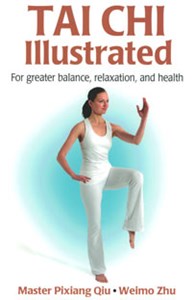Tai Chi Illustrated
|

|
| Author: |
Qiu P, Zhu W |
| Category: |
Health/Fitness |
| Audience: |
Consumer |
| Length: |
231 pages |
| Publisher: |
Human Kinetics |
| Year Published: |
2013 |
| List Price: |
$19.95 |
|
|
|
|
AthleteInMe.com®
Rating:



 Excellent!
Excellent!
Tai Chi Illustrated is an easy-to-use resource for consumers who wish to begin practicing Tai Chi.
Recommended for: Anyone who wants to reduce stress, and improve their leg strength and balance!
ABOUT THE AUTHORS
• Master Pixiang Qiu is director of the Chinese Wushu Research Center of Shanghai University of Sports. He is a veteran Tai Chi instructor and was named a national master of traditional exercise by the Chinese government. The International Wushu Federation named him as one of China's famous wushu professors in 1995, and, in 2003, rated him as a Chinese wushu ninth duan, the highest level in wushu. Professor Qiu has published many books in Chinese on Tai Chi and has lectured worldwide. In 2009, he gave the keynote address on Tai Chi at the American Alliance for Health, Physical Education, Recreation, and Dance (AAHPERD) convention.
• Weimo Zhu, PhD is an internationally recognized scholar in physical activity and health research at the University of Illinois in Urbana-Champaign where he teaches mind-body exercise classes at the university and in the community. He has practiced mind-body exercises, including Tai Chi and qigong, for more than 25 years. He was awarded an NIH grant to study the effects of mind-body exercise on cancer survivors and presented his research findings at the American College of Sports Medicine (ACSM) annual meeting in 2009.
CONTENT
The 231-page book is organized as follows:
PART I: TAI CHI BASICS
- Chapter 1: Art and Practice of Tai Chi
- Chapter 2: Basic Posture
- Chapter 3: Basic Foot Movements
- Chapter 4: Basic Hand Forms and Movements
- Chapter 5: Basic Stances
PART II: TAI CHI FORMS
- Chapter 6: Forms for Cardiovascular Health
- Chapter 7: Forms for Stress Relief and Low-Back Health
- Chapter 8: Forms for Balance
- Chapter 9: Forms for Coordination
PART III: TAI CHI ROUTINES
- Chapter 10: Six-Form Routine
- Chapter 11: Twelve-Form Routine
- Chapter 12: Basic Push Hands Routine
REVIEW
• Chapter 1: In this chapter, the authors provide a history of tai chi and a brief summary of some of the health benefits of performing it.
• Chapter 2: This chapter presents exactly what the title suggests: It reviews basic postures. Both the correct and incorrect postures are presented with color photographs.
• Chapter 3: This chapter addresses foot positions and foot movements. As with Chapter 2, color images are provided illustrating both the correct form and the incorrect form.
• Chapter 4: This chapter focuses on hand and arm movements. Like the previous chapters, color images are provided. But, here, directional arrows are included, a nice enhancement.
• Chapter 5: This chapter is titled "Basic Stances." Due to similar content, Chapter 2 and this chapter could have been combined.
• PART II demonstrates specific moves, or movements. In these chapters, color images and detailed descriptions show the reader how to perform a movement from beginning to end.
• PART III builds on what PART II presented. In PART III, a series of moves are combined in one continuous session. Chapter 10 presents a 6-form routine and Chapter 11 presents a 12-form routine. These are done solo. However, Chapter 13 requires a partner. These routines can be viewed as self-defense. In the explanatory comments for some of these moves, the authors use statements like "deflect the hit..." As with the prior chapters, numerous color photos are provided. In this final chapter, one subject is dressed in white while the other is dressed in black.
Other details about this book:
• Photos & Illustrations: Many color photos of subjects performing specific poses are provided. This is clearly a strength of this book.
• Tables & Graphs: No tables or graphs appear.
• Documentation / Accuracy: Several scientific publications and several web resources are listed on pp. 229-230.
WHAT I LIKED
This book explains Tai Chi -- something that many people may never have been exposed to before -- in an easy-to-understand way. The color photos enhance the reader's ability to learn the poses and routines.
WHAT COULD BE BETTER
The brief review of the health benefits of tai chi in Chapter 1 is only 3 pages long. I think this content should provide more details, especially regarding the ability of tai chi to prevent falls in the elderly. On page 13, the authors state that tai chi has not been shown to prevent falls in older people. However, a meta-analysis of 10 studies (Lomas-Vega R, et al. 2017) concluded that tai chi can dramatically reduce the risk of falls. Though this meta-analysis was published after the publication of Tai Chi Illustrated, several of the studies that were reviewed were published prior to that.
Because tai chi involves movement (unlike yoga where poses are held motionless), the images showing each movement could be substantially enhanced by providing directional arrows. This was included for the images in Chapter 4, but not for any of the others.
SUMMARY
I predict that, similar to the way that Americans embraced yoga during the past 2 decades, tai chi is going to become a mainstream form of exercise, too. Tai Chi Illustrated is an excellent resource for any person with no prior experience performing tai chi to learn this discipline, and, develop their own routine(s). I can recommend this book highly.
| Reviewed by: Stan Reents, PharmD |
4/13/2019 5:45:56 AM |
|